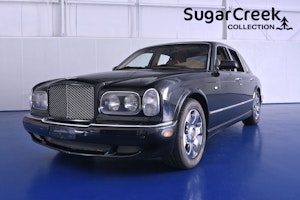Media | Articles
Fastback roofline gives the new Genesis G80 a dose of cool
The current Genesis G80 is already a luxury car worth consideration, even if we tend to talk more about its great-handling smaller sibling, the G70. Yet to introduce its new design language, Genesis launched its first SUV, the GV80, in January, only to follow up with the third-generation G80, a luxury sedan that’s making a strong statement with its sleek fastback body.
Whether or not you fancy the current trend of oversized grilles, the Genesis crest certainly feels more cohesive than anything BMW has managed to come up with lately. Next to that giant air intake, the G80 features quad headlamps as well as an inverse power bulge along its hood. This “Quad Lamp” theme continues across the (optional 20-inch, as shown) wheels through the front fender vents.

Behind the G80’s sloping decklid, we find the same LED design as at the front, with a chrome trim piece above the prominent Genesis badging and dual exhaust tips mimicking the grille’s shape.
The fastback look is a bold move from Genesis, but what’s even more impressive is that by using aluminum for 19 percent of the car’s body, Genesis managed to chop 275 pounds off third-gen car’s overall weight compared to the current G80. With the smallest engine (a 2.5-liter turbo inline-four), rear-wheel drive, and 18-inch wheels, the third-generation G80 weighs 3935 pounds.
Marketplace
Buy and sell classics with confidence
Next to that base engine, which makes 304 hp and 311 lb-ft of torque, certain markets are getting a 2.2-liter diesel with 210 horses and 325 lb-ft, while the top-of-the-range 3.5-liter V-6 is a 380-hp affair pushing out 390 lb-ft. Running on a 118.5-inch wheelbase, this rear-wheel-drive platform is also ready to house all-wheel drive in the future, just like the current G80.

Inside, Genesis reduced the number of hard buttons and switches, opting for a split view with a panoramic area above the air vents and the control zone below. The G80 features the combination of a heads-up display, a 12.3-inch instrument cluster screen, and a 14.5-inch touch-and-write infotainment system while retaining a rotary-operated electronic shift dial.
Most features can be controlled from the new steering wheel as well, while the driver and passengers can enjoy acres of leather and other soft-touch surfaces complemented by open-pore wood trim. Seating height has been lowered in the second row, compensating for the room cut by the new roofline. Rear passengers also get dual touchscreen displays.
To ensure a premium ride, there’s acoustic glass all around, along with improved door sealings, additional engine compartment insulation, and resonant sound-reducing wheels that work with the Electronically Controlled Suspension, aided by the feed of a frontal camera.
When it comes to gadgets and safety, Genesis threw in Remote Smart Parking Assistant, full smartphone integration, wireless updates to the navigation system, ten airbags, twin-filter air purification, and an “ergo motion seat function” which uses seven air cells to correct your posture at all times.
And with a chassis developed under handling guru and current Hyundai Group R&D boss Albert Biermann, this Genesis should be more than a car to sit in.












